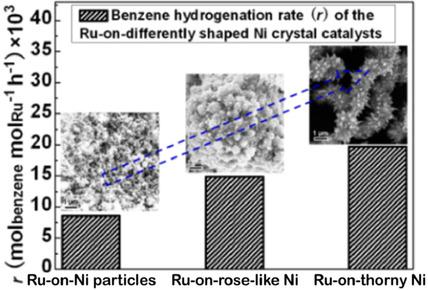当前位置:
X-MOL 学术
›
ChemCatChem
›
论文详情
Our official English website, www.x-mol.net, welcomes your
feedback! (Note: you will need to create a separate account there.)
Room‐Temperature Morphology‐Controlled Synthesis of Nickel and Catalytic Properties of Corresponding Ru/Ni Catalysts
ChemCatChem ( IF 3.8 ) Pub Date : 2019-06-03 , DOI: 10.1002/cctc.201900565 Lihua Zhu 1, 2 , Jingjing Cui 1 , Huan Zhang 2 , Luna Ruan 2 , Nan Ma 2 , Laixi Zou 2 , Tao Deng 2 , Bing Hui Chen 3 , Qiang Xiao 1
ChemCatChem ( IF 3.8 ) Pub Date : 2019-06-03 , DOI: 10.1002/cctc.201900565 Lihua Zhu 1, 2 , Jingjing Cui 1 , Huan Zhang 2 , Luna Ruan 2 , Nan Ma 2 , Laixi Zou 2 , Tao Deng 2 , Bing Hui Chen 3 , Qiang Xiao 1
Affiliation

|
Differently shaped nickel crystals were obtained at ambient temperature via simple liquid chemical reduction by adding different surfactants (such as polyvinylpyrrolidone (PVP) or cetyltrimethylammonium bromide (CTAB)), with hydrazine hydrate as reducing agent and ethanol as solvent. Nickel nanoparticles (NPs), thorny nickel nanowires or rose‐like nickel crystals were obtained in the synthesis process without any surfactant, with PVP or with CTAB, respectively. The corresponding ruthenium‐on‐Ni crystal supported catalysts (Ru/Ni) were synthesized through galvanic replacement. Their catalytic behavior was tested in the model reaction of the hydrogenation of benzene. The order of their catalytic activity was Ru/thorny Ni nanowire > Ru/rose‐like Ni > Ru/Ni NPs due to different shapes and structures of Ru/Ni. The Ru/thorny Ni nanowires catalyst also exhibited outstanding stability for benzene hydrogenation to cyclohexane. The as‐obtained Ni and Ru/Ni samples were characterized by X‐ray diffraction (XRD), scanning electronic microscopy (SEM), SEM energy dispersive X‐ray spectroscopy (SEM‐EDS), high‐sensitivity low‐energy ion scattering spectroscopy (HS‐LEIS), X‐ray photoelectron spectroscopy (XPS), SEM‐EDS elemental mapping, transmission electron micro‐scope (TEM), and high resolution TEM (HRTEM), to reveal their morphologies, structures and element distribution and further illustrate the intrinsic reasons for their different performance in catalyzing benzene hydrogenation.
中文翻译:

室温下形态学控制的镍合成及相应的Ru / Ni催化剂的催化性能
通过添加不同的表面活性剂(例如聚乙烯吡咯烷酮(PVP)或十六烷基三甲基溴化铵(CTAB)),以水合肼为还原剂,乙醇为溶剂,通过简单的液体化学还原在室温下获得不同形状的镍晶体。在合成过程中,不使用任何表面活性剂,分别使用PVP或CTAB即可获得镍纳米粒子(NPs),棘手的镍纳米线或玫瑰状镍晶体。通过电置换合成了相应的钌-镍-镍晶体负载催化剂(Ru / Ni)。在苯加氢的模型反应中测试了它们的催化行为。由于Ru / Ni的形状和结构不同,它们的催化活性顺序为Ru /棘手的Ni纳米线> Ru /类玫瑰镍> Ru / Ni NPs。Ru /棘手的Ni纳米线催化剂对于苯加氢成环己烷也表现出出色的稳定性。通过X射线衍射(XRD),扫描电子显微镜(SEM),SEM能量色散X射线光谱法(SEM-EDS),高灵敏度低能量离子散射光谱对获得的Ni和Ru / Ni样品进行表征(HS‐LEIS),X射线光电子能谱(XPS),SEM‐EDS元素映射,透射电子显微镜(TEM)和高分辨率TEM(HRTEM),以揭示它们的形态,结构和元素分布并进一步说明它们在催化苯加氢方面的不同性能的内在原因。
更新日期:2019-06-03
中文翻译:

室温下形态学控制的镍合成及相应的Ru / Ni催化剂的催化性能
通过添加不同的表面活性剂(例如聚乙烯吡咯烷酮(PVP)或十六烷基三甲基溴化铵(CTAB)),以水合肼为还原剂,乙醇为溶剂,通过简单的液体化学还原在室温下获得不同形状的镍晶体。在合成过程中,不使用任何表面活性剂,分别使用PVP或CTAB即可获得镍纳米粒子(NPs),棘手的镍纳米线或玫瑰状镍晶体。通过电置换合成了相应的钌-镍-镍晶体负载催化剂(Ru / Ni)。在苯加氢的模型反应中测试了它们的催化行为。由于Ru / Ni的形状和结构不同,它们的催化活性顺序为Ru /棘手的Ni纳米线> Ru /类玫瑰镍> Ru / Ni NPs。Ru /棘手的Ni纳米线催化剂对于苯加氢成环己烷也表现出出色的稳定性。通过X射线衍射(XRD),扫描电子显微镜(SEM),SEM能量色散X射线光谱法(SEM-EDS),高灵敏度低能量离子散射光谱对获得的Ni和Ru / Ni样品进行表征(HS‐LEIS),X射线光电子能谱(XPS),SEM‐EDS元素映射,透射电子显微镜(TEM)和高分辨率TEM(HRTEM),以揭示它们的形态,结构和元素分布并进一步说明它们在催化苯加氢方面的不同性能的内在原因。































 京公网安备 11010802027423号
京公网安备 11010802027423号